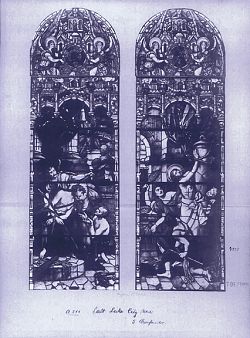Search for lost Cathedral of the Madeleine windows, missing since World War I, goes on, spurred by new information

By Gary Topping SALT LAKE CITY — As the Most Rev. Lawrence Scanlan, then bishop of Salt Lake City, planned the design of the Cathedral of the Madeleine, he envisioned three of the building’s sides with five windows each, representing the mysteries of the rosary. In the west nave were the joyful mysteries, in the apse (north) were the sorrowful mysteries, and in the east nave were the glorious mysteries. The joyful and glorious mysteries are depicted in order, from left to right, just as one says the rosary. The sorrowful mysteries, though, had to be slightly rearranged so that the Crucifixion, the culmination of the Passion drama, would be situated in the center over the main altar, rather than on the far right, where it appears on the rosary. Thus, the order from left to right was the Agony in the Garden, the Scourging at the Pillar, the Crucifixion, the Crowning With Thorns, and the Carrying of the Cross. In the Cathedral today, the windows on both sides of the nave are still there, but the apse windows were removed during World War I by Bishop Joseph S. Glass and replaced by two more abstract windows and a huge mural by artist Felix Lieftuchter depicting the Crucifixion flanked on each side by figures from the Old and New testaments (other decorations were added as well). Those alterations have given rise to two problems that have vexed Cathedral historians ever since: What happened to the removed windows, and what did the windows depict? We know what the subjects of the windows were, but there are no photographs that show how the artists rendered them. The first problem remains unresolved. Some have speculated that the three central windows are still there, having only been encased in plaster. But not only do we have a document in Bishop Glass’s hand recording their removal, but also, during the Cathedral renovation in the 1970s, the plaster was drilled to see if anything was inside, and the spaces were empty. Archbishop Robert J. Dwyer of Portland, Ore., who grew up in the Cathedral parish and once served as its rector, wrote to Msgr. William H. McDougall in the 1960s that the windows had been taken to Boise, whose cathedral was built during the First World War. Subsequent investigation, though, has disclosed that the Cathedral of the Madeleine windows did not go there. So where did they go? One can hardly imagine the destruction of such magnificent works of art, nor can one imagine reinstallation in any other structure than a church. But which church? We simply do not know. The other problem – what the windows looked like – recently has been at least partly solved. Last fall, Msgr. Joseph M. Mayo, Cathedral rector, received a book from the firm Franz Mayer of Munich (which, after 1862, included the F. X. Zettler firm, which built our windows) giving the history of the company and advertising some of their creations, including the Cathedral of the Madeleine’s rose window. The firm still thrives, employing more than over 600 people in their shop. Prompted by that knowledge, I wrote to Dr. Gabriel Mayer, the current president, to ask if their archive might include illustrations of our missing windows. In his reply, he indicated that although most of their archive was destroyed during World War II, he found illustrations of two of the missing windows: The Crowning with Thorns and The Scourging at the Pillar. Is this the end of the search? Not necessarily. Although Dr. Mayer indicates that their damaged archive probably contains no illustrations of the other windows, we cannot close the door on that possibility. Also, there is always the tantalizing possibility that the windows themselves may yet turn up. What a find that would be! (Gary Topping is the archivist for the Diocese of Salt Lake City. His column, "From the Archives," is on the diocesan website, www.dioslc.org.)
© Copyright 2024 The Diocese of Salt Lake City. All rights reserved.

Stay Connected With Us